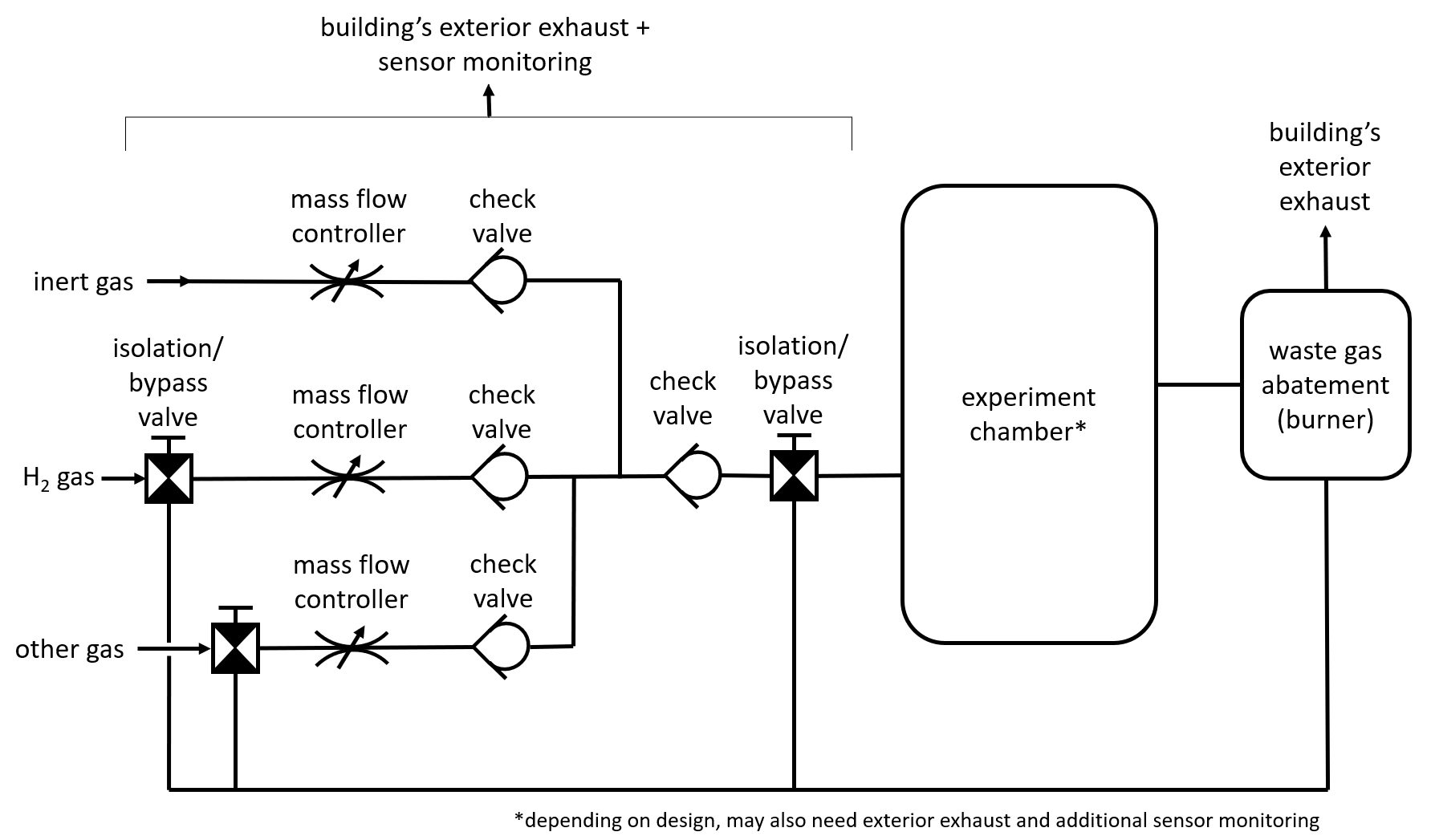
What are the hazards of hydrogen gas?
Hydrogen gas (CAS# 1333-74-0) is not toxic to breathe, although it can function as an asphyxiant if it displaces enough breathable air. Hydrogen gas has a low LEL and a broad flammability range, so the flammability/explosivity hazard becomes a risk before hydrogen can displace that much breathable air. The LEL, or lower explosive/flammable limit, is the lowest volume percent in air at which the gas can flash or catch fire in the presence of heat or sparks. The LEL for hydrogen is 4%, and it remains quite flammable all the way up to 77% in air (77% is the UEL, or upper explosive/flammable limit).
Sparks, static discharge arcs, and similarly-hot surfaces can ignite hydrogen-air mixtures at or above 4%. This includes any pumps being used in the tool setup, and situations where electrostatic discharges in exhaust ducts where leaked or un-reacted hydrogen gas of 4% or more could result in fires or explosions within the exhaust ducts.
Hydrogen is much lighter than air and can become trapped near the ceiling above a leak.
Hydrogen is also a very small molecule. Not only can it leak out of fittings and joints in the gas system that larger-molecule gases might not leak through, but it is small enough to pass into and through the crystal lattice of metals. This includes stainless steel tubing, fittings, and other compressed gas system hardware. Hydrogen gas infiltration of metals can cause hydrogen embrittlement, resulting in the expansion of cracks along points of mechanical stress in the metal.
What if I'm using a low percentage of hydrogen mixed with an inert gas?
If the gas provider’s Safety Data Sheet (SDS) states that the gas mixture is nonflammable, then it can be treated like an inert gas mixture (except for matters involving reactivity with oxidizers, of course).
FSE requires signage posted on these installations indicating that only nonflammable gases are used. Signs are available for nonflammable forming gas mixtures and unspecified nonflammable gas mixtures; please contact Amanda.L.Hoyt@asu.edu or Rita.Bottesch@asu.edu for signage for any customized mixtures.
Flammable mixtures of hydrogen gas will require the infrastructural safety described below.
Required Documents
Hydrogen Gas Cylinder SOP template
Hydrogen Gas Generator SOP template
Hydrogen Safety Plan template (coming soon)
Hydrogen Gas Generator Maintenance Log
Gas Cabinet Function Test SOP – KE Hazardous Materials Operations
Nonflammable Gas Mixtures Only – Signage (contact your lab manager, or Amanda.L.Hoyt@asu.edu or Rita.Bottesch@asu.edu for a laminated sign)
Nonflammable Forming Gas Mixtures Only – Signage (contact your lab manager, or Amanda.L.Hoyt@asu.edu or Rita.Bottesch@asu.edu for a laminated sign)
Other Resources
Properties and Reactivity of Hydrogen – Cameo Chemicals
Hydrogen Fittings – Swagelok Tech Talk
Hydrogen Absorption into Austenitic Stainless Steels
Lessons Learned – Hydrogen Fire – ASU
Lessons Learned – Hydrogen Fire and Explosion – PNNL
Lessons Learned – Hydrogen Explosion – UH
Lessons Learned – Hydrogen Explosion – AB Specialty Silicones
How ASU’s Hydrogen Safety Documents were Developed and Reviewed
What will my lab need in order to work safely with Hydrogen gas?
All lines from the hydrogen gas source, and any other toxic or flammable gas sources, must have the following:
- Check valve / non-return valve between the gas source and the mixing or use chamber
- A bypass valve (3-way ball valve that allows for gas shut-off, and allows for the gas to bypass the use chamber and pass directly to exhaust – see Gas Schematic Template)
- If gases are mixed, the mixed gas must also have its own check valve and bypass line between the mixing chamber and use chamber.
- Anywhere there is a mechanical fitting, valve, or an operation area, gas monitoring and exterior exhaust is required above.
- If the entire apparatus with its connection points cannot be placed inside an exhausted cabinet, a canopy hood with a 6″ overhang beyond the perimiter of the tool/connection-point area may be used.

Design Requirements for the Experimental Apparatus
- Hydrogen gas can pass through the interstitial space of many solids and elastomers. Only use system/apparatus components that are specifically certified and rated for use with hydrogen gas at the highest pressures you might use.
- Due to small molecule size, the best-performing hydrogen gas fittings are ones that have the most surface-to-surface contact with each other. Fittings with a single point of contact, such as ball-and-cone fittings, can leak easily.
- Never re-use piping or fittings for flammable or toxic gases.
- Only clean 316 stainless steel piping, with orbitally welded connections, can be used for conveying pressurized hydrogen gas.
- All metal piping must keep a consistent diameter throughout the apparatus (1/4” diameter is recommended). Large-to-small pipe fittings create mechanical stress.
- H2 gas flow should be kept linear, with any other introduced gases coming in from side branches. Joints or bends in the piping must be orbitally welded by trained and certified personnel. Do not design your system with any hydrogen gas pipe bends or turns greater than 90°. Contact your lab manager for guidance.
- Hydrogen is small enough to pass into the interstitial spaces in the crystalline lattice of steel, which can cause embrittlement of steel and crack propagation. All H2 gas lines must be securely bracketed to structural supports in a way that prevents mechanical stress along the gas lines and fittings.
What are the requirements for the hydrogen gas source itself?
Hydrogen gas generators are highly recommended, since they lack the potential for catastrophic leaks and are less expensive/complicated to install and use.
Below are the requirements for compressed hydrogen cylinders:
- A gas cabinet (a manufactured gas cabinet vented to exterior exhaust) is required for hydrogen gas cylinders with 4% or more hydrogen. FSE strongly recommends having the gas cabinet electrically grounded.
- This cabinet must have gas sensors monitoring for leaks inside the cabinet. Pneumatic shutoff or automatic shutoff valves that shut off gas flow upon detection of a leak are strongly recommended.
- The gas panel/manifold and any other areas with gas connectors or valves must also have external exhaust and gas sensor monitoring.
- A Restricted Flow Orifice (RFO) is strongly recommended for all flammable and toxic compressed gas cylinders in FSE research labs. You will need to calculate the Flow Rates to determine which RFO to use. If not properly sized, you will not be able to achieve the flow rate you want to receive in the experiment.
Gas Sensor Requirements
Hydrogen gas or flammable gas detectors are required, in the breathing zone around the area of use (everything not in an exhausted enclosure), and any other locations where hydrogen could accumulate (fittings or valves).
Blue strobe lights, activated by high-level gas alarms, are required to indicate when the lab has a hazardous gas leak in progress. Where these blue lights are not visible through windows into the lab space, the lights must be placed outside any doors providing access to the room with the leak. It is also recommended to have a remote or web-accessible gas sensor display outside of the room to check levels without potentially entering a flammable environment.
Gas sensors should be calibrated to alarm at 4%. While you may observe different alarm set points in other units at ASU, FSE restricts the high level alarm to the LEL for work with flammable gases. If the installed gas sensors have the option for two alarm set points (low level and high level alarm), the low level alarm should be set at 2% and the high level alarm should be set at 4%.
A 4% H2 level detected by the sensor will trigger the general building alarm and force the evacuation of all labs and rooms in the building. In the event of high level alarm, the gas supply should shut down automatically through a pneumatic/automatic shutoff valve on the panel. The high level alarm will also trigger a blue strobe light, which must be visible through windows or exterior displays outside the lab.
Low level gas alarms will send a supervisory notification to the building’s fire alarm control panel, but there are no building fire horns/strobes. If the sensor registers more than 2%, immediately shut down any suspected leak sources. Press the Emergency Gas Shut Off button or close the valve on the hydrogen cylinder, if safe to do so.
All extractive gas sensors must be exhausted to the exterior of the building, the same as any other area or airflow that may contain hydrogen gas.
Where should the exhaust go?
All unused/excess and waste gases must be safely exhausted to the lab building’s exterior. If any parts of the experimental apparatus can be opened to the breathing space of the lab (such as a chamber where other materials are inserted/removed), those portions must be completely flushed with an inert gas before the chamber can be opened.
Since hydrogen gas is flammable and can be ignited by static discharges within exhaust ductwork, it must be abated prior to exhausting out the ducts. This can be done by either diluting the gas so that hydrogen is well below 4%, or by passing the gas through an abatement device. Since hydrogen is most easily abated through combustion, this device is often referred to as a burn box.
Gas abatement devices are only designed to handle specific gases. If non-hydrogen gases will be used or generated in the apparatus during the process, check with the gas abatement manufacturer and provide the manufacturer with the highest gas flow rates that might be used. Ensure all gases are compatible with the abatement system, and that gases emitted into the exhaust meet both ASU and national safety & emissions regulations. (ASU EHS will review the plan to ensure emissions are appropriately addressed.)
What else needs to happen before I can start using hydrogen gas in my lab?
Before the first time the gas cylinder(s) can be brought to the research lab,
or if the system is moved to a new location,
or if any modifications are made to the system,
then the system must be fully checked for functionality.
This includes:
- Leak testing with an inert gas (preferably helium, to match the small molecule size of the intended use gas)
- Gas cabinet function tests, according to KE Hazardous Materials Operations team’s Standard Operating Procedure
- Gas sensor testing, including fire alarm panel codes, power outage testing, sensor-initiated pneumatic gas shut-down
- Testing of the EMO gas shut-down button


